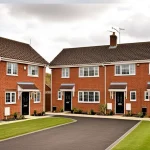Integrating Biophilic Design in UK Homes: Core Principles and Benefits
Biophilic design basics focus on reconnecting people with nature by incorporating natural elements into living spaces. In UK home design, this means using greenery, natural light, water features, and materials that evoke the outdoors. The core elements include plants, natural textures, daylight optimisation, and views of nature, all tailored to the unique British climate and lifestyle.
The benefits of biophilic design in the UK extend beyond aesthetics. Physically, increased exposure to natural light helps regulate circadian rhythms, boosting energy levels in often dim British winters. Psychologically, connection to nature reduces stress and enhances mood, important for the predominantly indoor lifestyle of many UK residents. These advantages improve overall wellbeing and contribute to a calmer, healthier home environment.
In parallel : What are effective strategies for organizing small UK apartments?
Key principles for successful integration in British homes involve thoughtful placement of natural elements to suit varying weather patterns and space types. Using native or UK-friendly plants indoors ensures longevity and easy maintenance. Maximising natural light through window treatments and layout choices complements the cooler British climate. Finally, blending biophilic design basics with traditional or modern UK home styles creates a harmonious, inviting space that celebrates nature’s presence indoors.
Practical Ways to Add Biophilic Design Elements Indoors
Integrating indoor plants UK is one of the most effective ways to embrace biophilic design basics inside British homes. Selecting UK-friendly species such as ferns, spider plants, or peace lilies ensures they thrive in typical indoor conditions. Positioning plants strategically—near windows or in corners needing soft visual interest—enhances natural connections and air quality.
Also to see : How Can Sustainable Home Decor Enhance Your Wellbeing?
Maximising natural light is crucial for the effectiveness of indoor plants and overall ambience. In many UK homes, which often struggle with limited daylight, methods like using sheer curtains, reflective surfaces, or rearranging furniture to open window areas can significantly boost light levels without costly renovations.
Incorporating natural materials for interiors like wood, stone, and wool introduces texture and warmth, key elements of biophilic design for UK residences. Wooden furniture or stone accents, paired with wool textiles, create tactile contrasts that evoke nature’s calming presence. These materials also offer sustainable options, aligning comfort with environmental care.
Together, these practical elements create a cohesive biophilic atmosphere indoors, encouraging wellbeing through natural light, plant life, and tactile materials suited to the UK’s climate and living conditions.
Biophilic Design on a Budget and for Different Home Types
Finding affordable ways to embrace biophilic design basics in UK homes is practical, even for renters or those with limited funds. Simple additions like potted indoor plants UK—such as English ivy or snake plants—bring greenery without breaking the bank. Choosing versatile décor like natural wooden trays or stone coasters adds subtle nature-inspired touches aligned with UK home styles.
DIY projects offer cost-effective solutions. For example, creating your own plant hangers or repurposing vintage wooden crates as planters introduces character while promoting sustainability. These accessible ideas accommodate both modern flats and traditional houses.
Adjusting biophilic elements to fit various home types is essential. In smaller apartments, compact plant varieties and multipurpose natural-finish furniture maximise space and connection to nature. Meanwhile, spacious UK homes can incorporate larger natural materials and more abundant greenery.
Across budgets and property types, the key is blending affordable nature-inspired décor that feels authentic and enhances wellbeing. By focusing on elements like light-accessible plants, tactile natural materials, and creative, low-cost implementations, homeowners and renters alike can enjoy the benefits of biophilic design tailored to their living environment.




